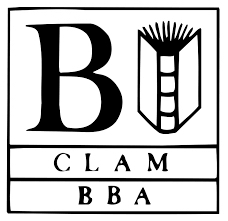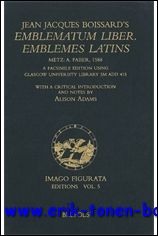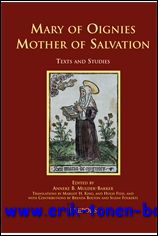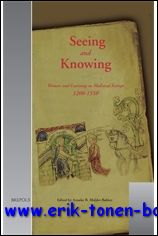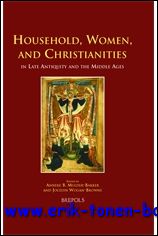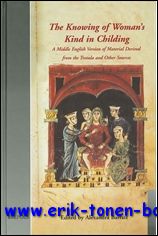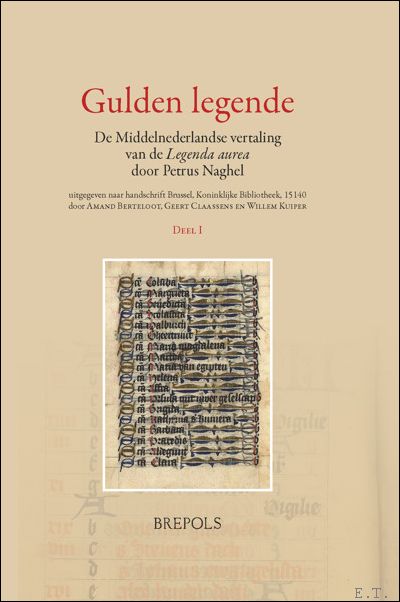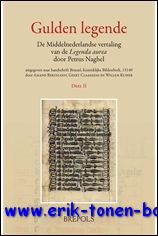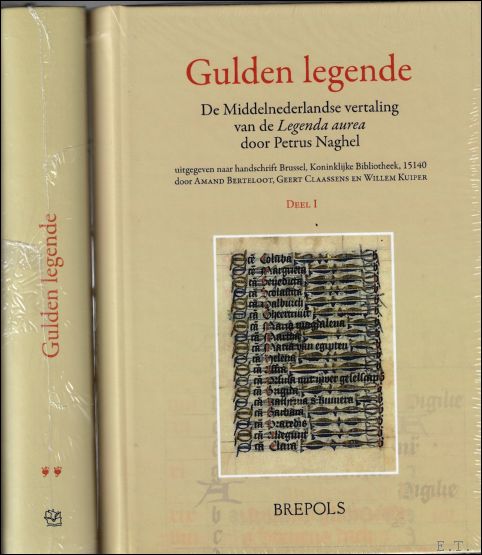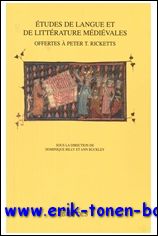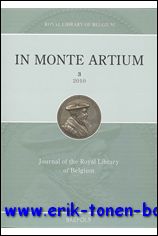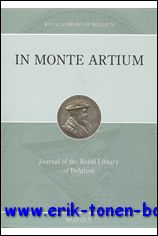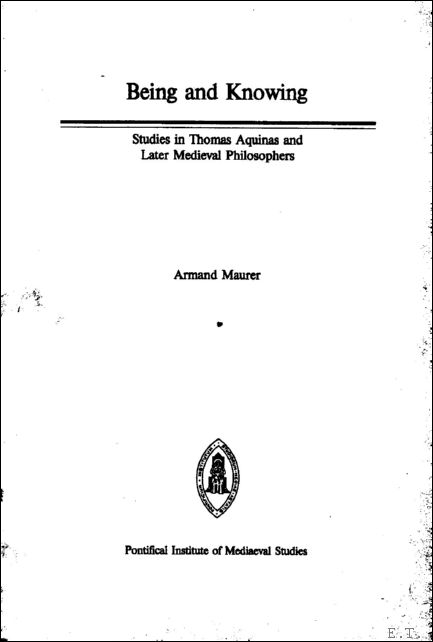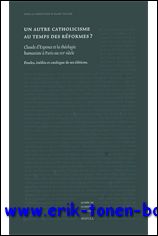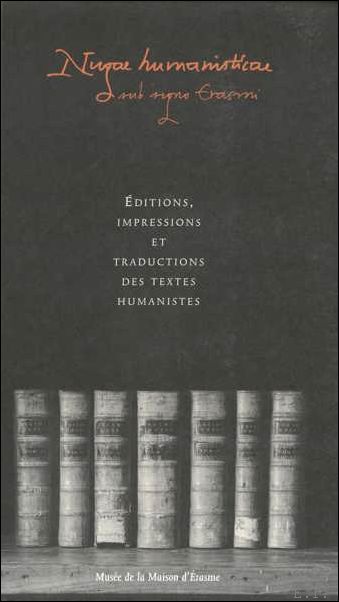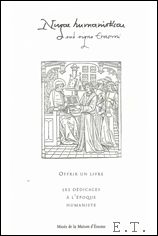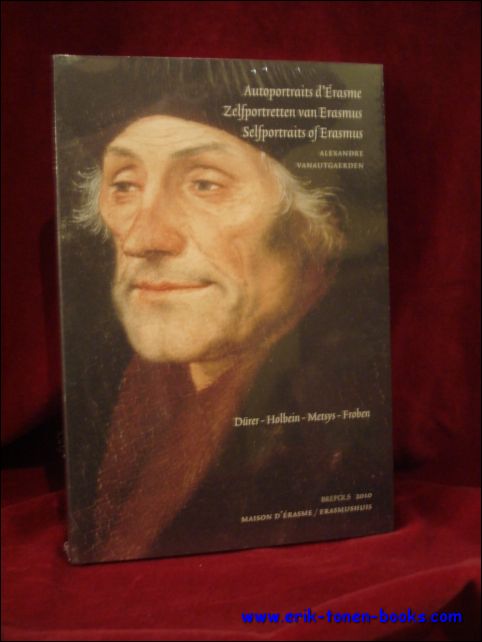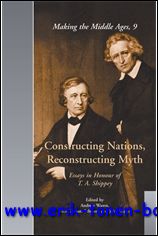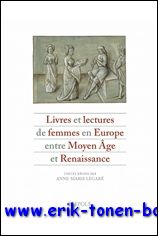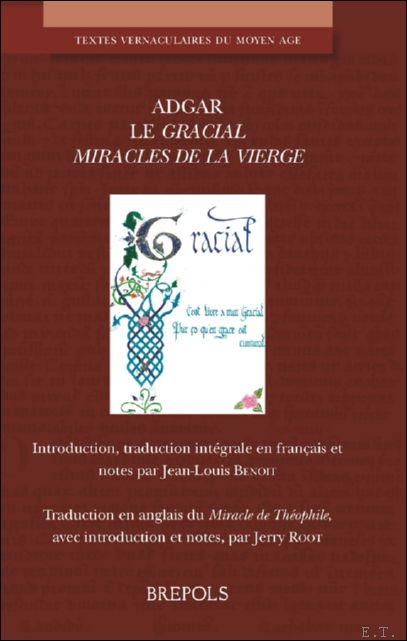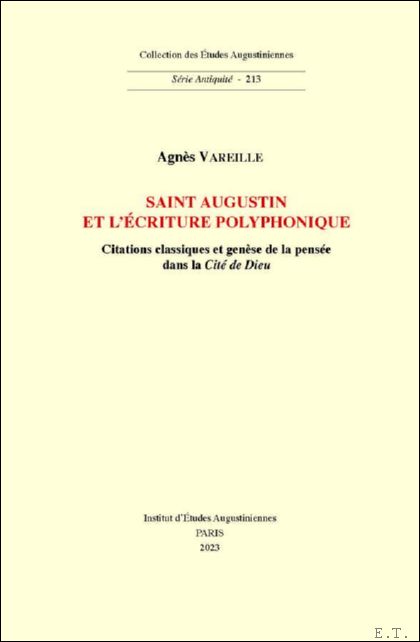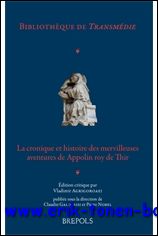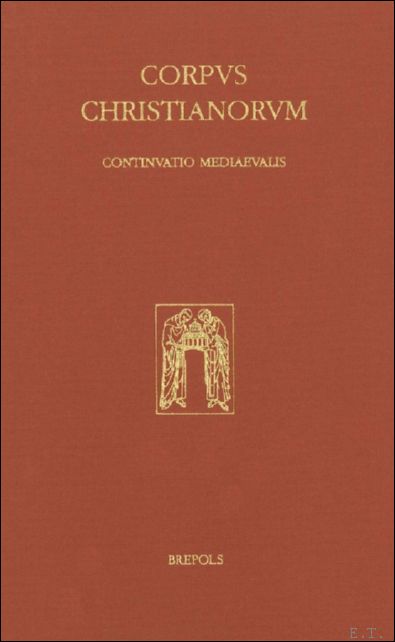R Sciences
487 livres trouvéz
A. Adams (ed.);
Jean Jacques Boissard's Emblematum liber / Emblemes latins (Metz,1588). Metz, A. Faber, 1588
Facsimile Edition Using Glasgow University Library SM Add 415, with a Critical Introduction and Notes,
Turnhout, Brepols, 2006. Hardback, XXIV+172 p., 160 x 235 mm. ISBN: 9782503517551
Boissard's Emblematum liber (1588) is one of the most complex and fascinating we possess: it comprises 42 emblems, each occupying an opening, with a quatrain in Latin by Boissard, a sonnet in French by Pierre Joly, and sophisticated engravings, many of them including more text, much of it in Greek. It is a daunting work but one which amply repays study and attention. Two particularly interesting features are 1) the autograph manuscript at the Bibliotheque de l'Institut in Paris which, as well as giving Boissard's own pictura, almost certainly used by the engraver, contains a prose commentary in French, and 2) the Brussels copy of the 1588 edition, a presentation copy to Louis Malarmey, which has Greek citations of relevance to our understanding of the emblems added, again in Boissard's own hand. I would need to refer to these regularly. The edition includes a critical introduction, situating the work, and a substantial critical apparatus. Languages : English, Latin, French.
Référence: 39053 | Prix: EUR 71.50
A. B. Mulder-Bakker (ed.);
Living Saints of the Thirteenth Century The Lives of Yvette, Anchoress of Huy; Juliana of Cornillon, Author of the Corpus Christi Feast; and Margaret the Lame, Anchoress of Magdeburg,
Turnhout, Brepols, 2012. Hardback, IX+416 p., 156 x 234 mm. ISBN: 9782503520773
This volume presents translations, with accompanying introductions, of the Lives of three thirteenth-century figures: Yvette of Huy, Margaret the Lame of Magdeburg, and the anchoress Juliana of Cornillon. This volume presents the Lives of three women of the thirteenth century, all written by contemporaries. In the late Middle Ages, almost every town in Northern Europe had its own anchoress, who would keep in touch with the citizens through a window looking onto the churchyard or through a door and window looking into the church (as shown in the cover illustration). Such women, along with the beguines, Cistercian nuns and monks, reform-minded clergy, and devout laywomen, formed what Barbara Newman has termed 'close-knit networks of spiritual friendship that easily crossed the boundaries of gender, religious status, and even language'. This volume presents the lives of two recluses, Yvette of Huy, whose life was recorded by her spiritual friend, the Premonstratensian Hugh of Floreffe, and Margaret the Lame of Magdeburg, whose lessons were recorded by her confessor, the Dominican John of Magdeburg (introduced and translated by Jo Ann McNamara, and Gertrud Jaron Lewis and Tilman Lewis respectively). The anchoress Eve of Saint-Martin was an author herself. Her memoir in French on her friend Juliana's and her own labour for the new Feast of Corpus Christi forms the basis of the Latin Life of Juliana of Cornillon (introduced and translated by Barbara Newman). Languages : English, Latin.
Référence: 40041 | Prix: EUR 104.50
A. B. Mulder-Bakker (ed.);
Mary of Oignies Mother of Salvation,
Turnhout, Brepols, 2007. Hardback, XII+260 pages., 1 b/w ill., 160 x 240 mm. ISBN: 9782503517032
This volume contains translatiuons of all of the relevant medieval sources on Mary of Oignies (1177-1213), was one of the first holy women to transform religious life in the late twelfth and early thirteenth centuries. Mary of Oignies (1177-1213) was one of the first holy women to transform religious life in the late twelfth and early thirteenth centuries. Living as a beguine and a free anchoress she guided those who came to speak with her, both high clerics and common people alike. In the oral world of medieval Christianity one disregarded her word at considerable risk. This volume contains all of the relevant medieval sources on Mary of Oignies, translated by Margot King and Hugh Feiss OSB. They include: the Life written by her confessor, James of Vitry, and the Supplement thereof by Thomas of Cantimpre; the liturgical office of her feast-day; and the 'History of the Priory of Oignies'. Also included are an introductory essay about her life and significance, written by Anneke Mulder-Bakker; a study about Mary as a 'friend to the saints' by Brenda Bolton; and the manuscript transmission of her Life, by Suzan Folkerts. The volume therefore provides a comprehensive 'companion' to Mary of Oignies and her wider significance in medieval and modern scholarship. Languages : English.
Référence: 40029 | Prix: EUR 59.99
A. B. Mulder-Bakker (ed.);
Seeing and Knowing Women and Learning in Medieval Europe, 1200-1550,
Turnhout, Brepols, 2004. Hardback, X+205 p., 1 b/w ill., 160 x 240 mm. ISBN: 9782503514482
The studies within this volume apply insights gained from gender studies to re-consider the way knowledge and learning was transmitted in medieval Europe 1200-1550. Traditional scholarship has largely concentrated on the clerical and academic context of conventional learning. It tended to focus on the contents and methods of formal education, as well as on a small group of educational institutions from which women were excluded. In this volume, authors consider how learning was transmitted outside the schools, in particular within women's communities. They raise a range of questions: how was knowledge transmitted in an oral context, what varieties of knowledge were available to communities of women? What kinds of learning are characteristic of such communities? What techniques did women develop to preserve and transmit their knowledge and how was it valorized both within their communities, and by 'authoritative' outsiders? Under what circumstances could women themselves gain authority in passing on knowledge to a wider audience? Languages : English.
Référence: 40033 | Prix: EUR 82.50
A. B. Mulder-Bakker, J. Wogan-Browne (eds.);
Household, Women, and Christianities in Late Antiquity and the Middle Ages,
Turnhout, Brepols, 2006. Hardback, X+262 p., 160 x 240 mm. ISBN: 9782503517780
The essays within this volume unite study of the medieval household with that of women's religious practices, providing a new avenue of enquiry the history of the church. Both as God's house and as the dwellings of his monastic and other followers, the history of the church is in part that of an institution conceived as a household. In recent years, secular life and lifestyles in late antiquity and the Middle Ages have been illuminated through renewed attention to the economic and social history of households, while scholarship on women has produced studies of the lives and the devotional reading of laywomen and women religious. This volume is a pioneering collection that unites study of the household with women's religious practices as a focus of enquiry. It moves beyond consideration of the church's roles in women's history to the impact of women's householding on the history of the church. Languages : English.
Référence: 40036 | Prix: EUR 49.50
A. Barratt;
The Knowing of Woman's Kind in Childing
A Middle English Trotula-Text,
Turnhout, Brepols, 2002. Hardback, XII+169 p., 160 x 240 mm. ISBN: 9782503510736
This study comprises a critical edition, using all the five extant MSS, of the most popular of the Middle English gynaecological texts deriving from the Latin Trotula-text. This study comprises a critical edition, using all the five extant MSS, of the most popular of the Middle English gynaecological texts deriving from the Latin Trotula-text. The Knowing of Women's Kind in Childing is a short fifteenth-century prose treatise which claims to be translated from Latin texts (or Latin and French, according to some manuscripts) that derive ultimately from the Greek. It has a unique importance as it was written by a woman, for a female audience, and on the subject of women. The text considers women's physical constitution, what makes them different from men (primarily the possession of a womb) and, in particular, the three types of problem that the womb causes. That it was written for a female audience is made explicit in the Prologue where the writer explains that he has translated this text out of French and Latin into English because literate women are more likely to read English than any other language and can then pass on the information it contains to illiterate women. More controversial must be the claim that this text was written by a woman. The text is a translation, no doubt by a man, but one of his ultimate sources was a text attributed to 'Trotula', in the Middle Ages believed to be the name of a midwife or gynaecologist from Salerno, who wrote extensively on women's ailments, childbirth and beauty care. Recent work shows that such a woman, probably named Trota, did exist and that she did write a gynaecological treatise, the Trotula or 'little Trota', which became closely associated with two other texts not by her. All three however became very popular and were widely disseminated under her name. Large sections of The Knowing of Woman's Kind come, via an Old French translation, from a version of the Liber de Sinthomatibus Mulierum (the Cum auctor), the first element in this Trotula ensemble. Languages : English.
Référence: 40026 | Prix: EUR 66.00
A. Berteloot, G. Claassens, W. Kuiper (eds.);
Petrus Naghel Gulden Legende
De Middelnederlandse vertaling van de 'Legenda aurea' door Petrus Naghel, uitgegeven naar handschrift Brussel, Koninklijke Bibliotheek, 15140. Deel I.
Turnhout, Brepols, 2012. Hardback, 411 pages ., 156 x 234 mm. *volume 1 only ISBN: 9782503544618
The importance of the Legenda aurea for the Late Middle Ages can hardly be overestimated, as witness the impressive manuscript tradition of the original Latin text as well the different vernacular versions. This huge hagiographic collection, organised per circulum anni, can be considered as a compendium of the medieval religious worldview: it offers insights into the (deuterocanonic) tradition of the New Testament, the lives and deaths of the most important saints, the history of the church of Rome, and it can be read as a catechism in narrative form. But the Legenda aurea is also a treasure-trove of stories, motifs and themes splendidly reflecting medieval mentality in its entirety. The influence of the Legenda aurea on literature and iconography is so far-reaching, that the book is an indispensable aid for the 'reading' of countless medieval texts, paintings and sculptures. The text was translated several times into Middle Dutch and of the first southern Dutch translation (ca. 1357), made by Petrus Naghel (? 1395) in the Charterhouse of Herne, a modern edition is now available. This edition of the Gulden legende - the second volume of a set of two - contains the legends of Pope Urban to the Feast of Church Dedication, and carries a concise introduction. The first volume of the set will appear in print in 2013; it contains the remaining legends and an expansive introduction comprising an introduction of text and translator, a description of the manuscript used for the edition, a statement of editorial policy and indices of names. Het belang van de Legenda aurea in de late Middeleeuwen kan moeilijk overschat worden, getuige de indrukwekkende handschriftelijke overlevering van zowel de oorspronkelijke Latijnse tekst als van de verschillende volkstalige versies. Deze omvangrijke hagiografische verzameling, georganiseerd per circulum anni, kan beschouwd worden als een compendium van het middeleeuwse religieuze wereldbeeld: het biedt inzicht in de (deuterocanonieke) traditie van het Nieuwe Testament, het leven en sterven van de belangrijkste heiligen, de geschiedenis van de Kerk van Rome en het kan gelezen worden als een catechismus in narratieve vorm. Maar de Legenda aurea is ook een schatkamer van verhalen, motieven en themata waarin de gehele middeleeuwse mentaliteit een schitterende weerspiegeling vindt. De invloed van de Legenda aurea op de literatuur en de beeldende kunsten is zo verregaand dat het boek een onmisbaar hulpmiddel is voor het ?lezen? van talloze middeleeuwse teksten, schilderijen en sculpturen. De tekst werd meermaals in het Middelnederlands vertaald en van de eerste, Zuidnederlandse vertaling, rond 1357 vervaardigd door de Hernse kartuizer Petrus Naghel (?1395) is nu een kritische uitgave beschikbaar. Deze editie van de Gulden legende - het tweede deel van wat een tweedelige uitgave wordt - bevat de legenden van paus Urbanus tot en met Kerkwijding, en wordt voorafgegaan door een beknopte inleiding. Het eerste deel zal volgens plan in 2013 verschijnen en de resterende legenden bevatten, maar ook een uitvoerige inleiding met, onder andere, een introductie van tekst en vertaler, een beschrijving van het gebruikte basishandschrift, editieprincipes en indices op namen. Languages : Dutch, Middle Dutch.
Référence: 62770 | Prix: EUR 132.00
A. Berteloot, G. Claassens, W. Kuiper (eds.);
Petrus Naghel Gulden Legende
De Middelnederlandse vertaling van de 'Legenda aurea' door Petrus Naghel, uitgegeven naar handschrift Brussel, Koninklijke Bibliotheek, 15140. Deel II,
Turnhout, Brepols, 2012. Hardback, 621 pages ., 156 x 234 mm. deel 2 only ISBN: 9782503542720
The importance of the Legenda aurea for the Late Middle Ages can hardly be overestimated, as witness the impressive manuscript tradition of the original Latin text as well the different vernacular versions. This huge hagiographic collection, organised per circulum anni, can be considered as a compendium of the medieval religious worldview: it offers insights into the (deuterocanonic) tradition of the New Testament, the lives and deaths of the most important saints, the history of the church of Rome, and it can be read as a catechism in narrative form. But the Legenda aurea is also a treasure-trove of stories, motifs and themes splendidly reflecting medieval mentality in its entirety. The influence of the Legenda aurea on literature and iconography is so far-reaching, that the book is an indispensable aid for the 'reading' of countless medieval texts, paintings and sculptures. The text was translated several times into Middle Dutch and of the first southern Dutch translation (ca. 1357), made by Petrus Naghel (? 1395) in the Charterhouse of Herne, a modern edition is now available. This edition of the Gulden legende - the second volume of a set of two - contains the legends of Pope Urban to the Feast of Church Dedication, and carries a concise introduction. The first volume of the set will appear in print in 2013; it contains the remaining legends and an expansive introduction comprising an introduction of text and translator, a description of the manuscript used for the edition, a statement of editorial policy and indices of names. Het belang van de Legenda aurea in de late Middeleeuwen kan moeilijk overschat worden, getuige de indrukwekkende handschriftelijke overlevering van zowel de oorspronkelijke Latijnse tekst als van de verschillende volkstalige versies. Deze omvangrijke hagiografische verzameling, georganiseerd per circulum anni, kan beschouwd worden als een compendium van het middeleeuwse religieuze wereldbeeld: het biedt inzicht in de (deuterocanonieke) traditie van het Nieuwe Testament, het leven en sterven van de belangrijkste heiligen, de geschiedenis van de Kerk van Rome en het kan gelezen worden als een catechismus in narratieve vorm. Maar de Legenda aurea is ook een schatkamer van verhalen, motieven en themata waarin de gehele middeleeuwse mentaliteit een schitterende weerspiegeling vindt. De invloed van de Legenda aurea op de literatuur en de beeldende kunsten is zo verregaand dat het boek een onmisbaar hulpmiddel is voor het ?lezen? van talloze middeleeuwse teksten, schilderijen en sculpturen. De tekst werd meermaals in het Middelnederlands vertaald en van de eerste, Zuidnederlandse vertaling, rond 1357 vervaardigd door de Hernse kartuizer Petrus Naghel (?1395) is nu een kritische uitgave beschikbaar. Deze editie van de Gulden legende - het tweede deel van wat een tweedelige uitgave wordt - bevat de legenden van paus Urbanus tot en met Kerkwijding, en wordt voorafgegaan door een beknopte inleiding. Het eerste deel zal volgens plan in 2013 verschijnen en de resterende legenden bevatten, maar ook een uitvoerige inleiding met, onder andere, een introductie van tekst en vertaler, een beschrijving van het gebruikte basishandschrift, editieprincipes en indices op namen. Languages : Dutch, Middle Dutch.
Référence: 39880 | Prix: EUR 132.00
A. Berteloot, G. Claassens, W. Kuiper (eds.);
Petrus Naghel Gulden Legende, Deel I en II, 2 volumes.SET
Turnhout, Brepols, 2012. Hardback, 2 volumes., approx. CXCVI+1030 pages ., 3 b/w ill. + 2 colour ill., 156 x 234 mm,
Languages : Dutch, Middle Dutch. ISBN: 9782503545028 The importance of the Legenda aurea for the Late Middle Ages can hardly be overestimated, as witness the impressive manuscript tradition of the original Latin text as well the different vernacular versions. This huge hagiographic collection, organised per circulum anni, can be considered as a compendium of the medieval religious worldview: it offers insights into the (deuterocanonic) tradition of the New Testament, the lives and deaths of the most important saints, the history of the church of Rome, and it can be read as a catechism in narrative form. But the Legenda aurea is also a treasure-trove of stories, motifs and themes splendidly reflecting medieval mentality in its entirety. The influence of the Legenda aurea on literature and iconography is so far-reaching, that the book is an indispensable aid for the ?reading? of countless medieval texts, paintings and sculptures. The text was translated several times into Middle Dutch and of the first southern Dutch translation (ca. 1357), made by Petrus Naghel (? 1395) in the Charterhouse of Herne, a modern edition is now available. This edition of the Gulden legende ? the second volume of a set of two ? contains the legends of Pope Urban to the Feast of Church Dedication, and carries a concise introduction. The first volume of the set will appear in print in 2017; it contains the remaining legends and an expansive introduction comprising an introduction of text and translator, a description of the manuscript used for the edition, a statement of editorial policy and indices of names. Het belang van de Legenda aurea in de late Middeleeuwen kan moeilijk overschat worden, getuige de indrukwekkende handschriftelijke overlevering van zowel de oorspronkelijke Latijnse tekst als van de verschillende volkstalige versies. Deze omvangrijke hagiografische verzameling, georganiseerd per circulum anni, kan beschouwd worden als een compendium van het middeleeuwse religieuze wereldbeeld: het biedt inzicht in de (deuterocanonieke) traditie van het Nieuwe Testament, het leven en sterven van de belangrijkste heiligen, de geschiedenis van de Kerk van Rome en het kan gelezen worden als een catechismus in narratieve vorm. Maar de Legenda aurea is ook een schatkamer van verhalen, motieven en themata waarin de gehele middeleeuwse mentaliteit een schitterende weerspiegeling vindt. De invloed van de Legenda aurea op de literatuur en de beeldende kunsten is zo verregaand dat het boek een onmisbaar hulpmiddel is voor het ?lezen? van talloze middeleeuwse teksten, schilderijen en sculpturen. De tekst werd meermaals in het Middelnederlands vertaald en van de eerste, Zuidnederlandse vertaling, rond 1357 vervaardigd door de Hernse kartuizer Petrus Naghel (?1395) is nu een kritische uitgave beschikbaar. Deze uitgave werd opgesplitst in een set van twee delen. De editie begint met de Advent en eindigt met de legende van de heilige Pancratius, en bevat daarmee de legenden rond de drie grote feesten: Kerstmis, Pasen en Pinksteren. Daarnaast biedt de set ook een uitvoerige inleiding, waarin eerst de Latijnse Legenda aurea, haar auteur en haar overlevering kort aan de orde worden gesteld. Het zwaartepunt ligt op de Middelnederlandse tekst, zijn vertaler en diens bron, en op de overlevering ervan in handschriftelijke en gedrukte bronnen. Een aantal concordanties en een namenregister ontsluiten de legendenteksten en maken het mogelijk de Gulden Legende en de actuele edities van de Latijnse tekst parallel te raadplegen. Référence: 39881 | Prix: EUR 264.00
Languages : Dutch, Middle Dutch. ISBN: 9782503545028 The importance of the Legenda aurea for the Late Middle Ages can hardly be overestimated, as witness the impressive manuscript tradition of the original Latin text as well the different vernacular versions. This huge hagiographic collection, organised per circulum anni, can be considered as a compendium of the medieval religious worldview: it offers insights into the (deuterocanonic) tradition of the New Testament, the lives and deaths of the most important saints, the history of the church of Rome, and it can be read as a catechism in narrative form. But the Legenda aurea is also a treasure-trove of stories, motifs and themes splendidly reflecting medieval mentality in its entirety. The influence of the Legenda aurea on literature and iconography is so far-reaching, that the book is an indispensable aid for the ?reading? of countless medieval texts, paintings and sculptures. The text was translated several times into Middle Dutch and of the first southern Dutch translation (ca. 1357), made by Petrus Naghel (? 1395) in the Charterhouse of Herne, a modern edition is now available. This edition of the Gulden legende ? the second volume of a set of two ? contains the legends of Pope Urban to the Feast of Church Dedication, and carries a concise introduction. The first volume of the set will appear in print in 2017; it contains the remaining legends and an expansive introduction comprising an introduction of text and translator, a description of the manuscript used for the edition, a statement of editorial policy and indices of names. Het belang van de Legenda aurea in de late Middeleeuwen kan moeilijk overschat worden, getuige de indrukwekkende handschriftelijke overlevering van zowel de oorspronkelijke Latijnse tekst als van de verschillende volkstalige versies. Deze omvangrijke hagiografische verzameling, georganiseerd per circulum anni, kan beschouwd worden als een compendium van het middeleeuwse religieuze wereldbeeld: het biedt inzicht in de (deuterocanonieke) traditie van het Nieuwe Testament, het leven en sterven van de belangrijkste heiligen, de geschiedenis van de Kerk van Rome en het kan gelezen worden als een catechismus in narratieve vorm. Maar de Legenda aurea is ook een schatkamer van verhalen, motieven en themata waarin de gehele middeleeuwse mentaliteit een schitterende weerspiegeling vindt. De invloed van de Legenda aurea op de literatuur en de beeldende kunsten is zo verregaand dat het boek een onmisbaar hulpmiddel is voor het ?lezen? van talloze middeleeuwse teksten, schilderijen en sculpturen. De tekst werd meermaals in het Middelnederlands vertaald en van de eerste, Zuidnederlandse vertaling, rond 1357 vervaardigd door de Hernse kartuizer Petrus Naghel (?1395) is nu een kritische uitgave beschikbaar. Deze uitgave werd opgesplitst in een set van twee delen. De editie begint met de Advent en eindigt met de legende van de heilige Pancratius, en bevat daarmee de legenden rond de drie grote feesten: Kerstmis, Pasen en Pinksteren. Daarnaast biedt de set ook een uitvoerige inleiding, waarin eerst de Latijnse Legenda aurea, haar auteur en haar overlevering kort aan de orde worden gesteld. Het zwaartepunt ligt op de Middelnederlandse tekst, zijn vertaler en diens bron, en op de overlevering ervan in handschriftelijke en gedrukte bronnen. Een aantal concordanties en een namenregister ontsluiten de legendenteksten en maken het mogelijk de Gulden Legende en de actuele edities van de Latijnse tekst parallel te raadplegen. Référence: 39881 | Prix: EUR 264.00
A. Buckley, D. Billy (eds.);
Etudes de langue et de litterature medievales offertes a Peter T. Ricketts a l'occasion de son 70eme anniversaire,
Turnhout, Brepols, 2005. Paperback, XIV+744 p., 156 x 234 mm. ISBN: 9782503516400
Peter T. Ricketts, Honorary Professor of French at the University of Birmingham, and Emeritus Professor at Queen Mary and Westfield, University of London, has led a long and distinguished career in the field of Romance Philology, and in Occitan studies in particular. In addition to his leading role in the Association Internationale d'Etudes Occitanes (AIEO), he has devoted many years in the service of Occitan Studies. Peter T. Ricketts is perhaps especially noted for an in-progress edition (with Cyril P. Hershon) of the Breviari d'Amor by Matfre Ermengaud, and for the Concordance of Medieval Occitan (CMO), a vast database the aim of which is to document the entire corpus of medieval Occitan texts and to make them available in electronic format as an active and exhaustive working tool for all scholars in the field. The first tranche of this project, on the poetry of the troubadours (Brepols 2001), has already been received with wide critical acclaim. The present publication includes articles by 63 specialists in fields as wide-ranging as history, literature, linguistics, philology, musicology, metrics and philosophy, addressing sources and topics from a variety of provenances in Old French and Old Occitan, as also in Medieval Latin, Castilian, Catalan, Middle High German, Hispano-Arabic, and Hebrew. It is divided into two major sections. The first is concerned with narrative texts: romance, epic, and religious literature; the second with the poetry of the troubadours: firstly their lyric legacy, its sources and influences, the vidas which accompany their transmission, the troubadours themselves, but also instances of their non-lyric output such as proverbs and ensenhamens. Also among the articles are editions of texts, some hitherto unpublished. Taken together, this collection represents a very broad panorama of current research, and offers a major contribution to the advancement of Medieval Studies. " Honorary Professor " de Francais a l'Universite de Birmingham, et Professeur Emerite a Queen Mary and Westfield, Universite de Londres, Peter T. Ricketts a mene une carriere longue et remarquable dans le domaine de la Philologie Romane, et dans les etudes occitanes en particulier. Outre son role majeur dans l'animation de l'Association Internationale d'Etudes Occitanes (AIEO), Peter T. Ricketts a consacre de nombreuses annees aux etudes occitanes. Son ?uvre est plus specialement marquee par l'edition encore inachevee (avec Cyril P. Hershon) du Breviari d'Amor de Matfre Ermengaud, et l'elaboration de la Concordance de l'Occitan Medieval (COM), vaste banque de donnees appelee a terme a couvrir l'ensemble des textes occitans du moyen age et mettant a la disposition des chercheurs un outil de travail exhaustif et performant. La publication de la premiere tranche consacree a la poesie des troubadours (Brepols 2001) a deja recueilli un accueil tres favorable de la critique. Le present recueil de Melanges reunit les travaux de 63 specialistes de la litterature medievale, dans des domaines aussi varies que l'histoire, la litterature, la linguistique, la philologie, la musicologie, la metrique ou la philosophie, explorant des materiaux et des sources de diverses provenances, en ancien francais et en ancien occitan, mais aussi en latin medieval, castillan, catalan, moyen-haut-allemand, hispano-arabe, hebreux. L'ouvrage est divise en deux sections principales, la premiere etant consacree aux textes non lyriques : roman, epopee et litterature religieuse, la seconde a la poesie des troubadours, soit naturellement a leur production lyrique, a ses sources et son influence, aux vidas qui accompagnent leur transmission, aux troubadours eux-memes, mais aussi a leur production non lyrique tels que textes proverbiaux et ensenhamens. Ces Melanges incluent egalement quelques editions de textes, quelquefois inedits. Leur ensemble constitue un panorama tres complet des recherches actuelles, avec des avancees capitale dans le domaine des etudes medievales. Languages : French, Occitan.
Référence: 39865 | Prix: EUR 86.90
A. Chatelet, N. Goetghebeur;
Le musee des Beaux-Arts de Lille,
Turnhout, Brepols, 2006. Hardback, 255 p., 215 x 280 mm. ISBN: 9782870330135
Le Musee des Beaux-Arts de Lille possede une interessante collection de Primitifs flamands. Albert Chatelet, conservateur honoraire du musee et professeur emerite a l'universite Marc-Bloch de Strasbourg, assiste de Nicole Goetghebeur restauratrice en chef honoraire a l'Institut royal du Patrimoine artistique a Bruxelles, a entrepris l'etude rigoureuse des dix-neuf tableaux constituant cet ensemble. Le Paradis terrestre et l'Enfer de Dirk Bouts font l'objet d'un dernier etat de la question. De nouvelles prises de vues ont ete realisees a cette occasion et des documents techniques inedits emaillent l'abondante illustration photographique. On releve egalement l'analyse des portraits de Louis de Quarre et Barbe de Cruysinck et du Triptyque de la Vierge et l'Enfant, deux oeuvres appartenant au groupe du Maitre au feuillage en broderie, un artiste enigmatique dont la personnalite a ete recemment mise en relief par une exposition dans ce meme musee. Le Concert dans l'oeuf d'apres Jerome Bosch, le Portrait de Philippe le Bon de l'entourage de Rogier van der Weyden et des tableaux du Maitre au brocart d'or, du Maitre de 1499, du Maitre de la Famille de sainte Anne et de divers anonymes completent cet ensemble. Languages: French.
Référence: 37220 | Prix: EUR 62.00
A. Claridge, I. Herklotz;
Classical Manuscript Illustrations,
Turnhout, Brepols, 2012. Hardback, 424 p., 46 b/w ill. + 224 colour ill., 22 x 28,5. FINE ISBN: 9781905375769
The Paper Museum ('Museo Cartaceo') is a collection of some 10,000 drawings and prints assembled during the seventeenth century by the Roman patron and collector, Cassiano dal Pozzo, and his younger brother, Carlo Antonio. It represents one of the most significant attempts before the age of photography to embrace human knowledge in visual form, documenting ancient art and culture, architecture and topography, natural history and social customs. The 160 drawings catalogued in this volume are derived from five ancient manuscripts: the famous Vatican Vergil, the so-called 'Roman' Vergil, the Vatican Terence, and the less well-known Palatine Agrimensores, all in the Vatican Library, and from a fifth codex, now lost, known as the Chronography or Calendar of the year 354. The bulk of the drawings were copied for Cassiano between 1632 and 1634 for the purpose of studying both the characters depicted and the allied evidence of ancient costume and artefacts. By the later seventeenth century, when Pietro Santi Bartoli executed the last group of drawings in the present volume for Carlo Antonio, manuscript illustrations had come to be cherished as much for their rarity as examples of ancient painting as for their documentary value. Introductory essays provide an overview of the dal Pozzo commissions, the manuscripts and their history down to Cassiano's day, as well as their study in the wider context of classical scholarship through to the eighteenth century. All the drawings are reproduced in colour at full page, with accompanying descriptions of the subjects or relevant ancient verses in modern translation and brief commentaries. Languages : English.
Référence: 40473 | Prix: EUR 159.00
A. d. P. Healey, K. Kiernan (eds.);
Making Sense Constructing Meaning in Early English,
Turnhout, Brepols, 2008. Paperback, XII+138 p., 15 x 23. ISBN: 9780888449078
The five essays in this volume discuss texts either from the Old English period or from the transitional twelfth century, and each explores, from differing perspectives, how today?s readers make sense of, or construct meanings from, early English documents. Languages : English, Old English.
Référence: 41492 | Prix: EUR 18.70
A. Di Paolo Healey, D. McDougall, I. McDougall, N. Speirs, P. A Thompson;
Dictionary of Old English, Fasc. F,
Turnhout, Brepols, 2004. Microfiche, XXIV p., + 35 microfiches, 135 x 215 mm. ISBN: 9780888449290
Languages : English.
Référence: 37414 | Prix: EUR 55.00
A. Di Paolo Healey, J. Holland, D. Haines, D. McDougall, I. McDougall;
Dictionary of Old English, Fasc. G,
Turnhout, Brepols, 2009. Microfiche, XVI p., + 35 microfiches, 135 x 215 mm. ISBN: 9780888449313
Languages : English, Old English.
Référence: 37415 | Prix: EUR 24.00
A. Diels (ed.);
In Monte Artium. Journal of the Royal Library of Belgium, 3, 2010
Du trait de plume au coup de pinceau: gravures d'invention et de reproduction en Europe au XVIIe siecle. Journee d'etude, Bruxelles, Bibliotheque royale de Belgique, 27 novembre 2009.,
Turnhout, Brepols, 2011. Paperback, 213 p., 200 x 280 mm. ISBN: 9782503533285
Severine Lepape, Les editeurs de la rue Montorgueil et les gravures flamandes : la production des Mathoniere Vanessa Selbach, L'activite de l'editeur d'estampes parisien Jean Messager (vers 1570/75?-1649) : l'affirmation de la gravure fancaise du premier quart du XVIIe siecle, au carrefour des influences flamandes et italiennes Lena Widerkehr, La fortune de Hendrick Goltzius dans la dynastie des graveurs Matham, Jacob, le pere, et ses deux fils : assimilation du modele et adaptation au gout dans la premiere moitie du XVIIe siecle Frederic Jimeno Sole, La rivalite commerciale entre les editeurs d'estampes francais et flamands en Espagne : le temoignage de Jusepe Martinez (1669-1677) Karen Bowen en Dirk Imhof, Exchanges between friends and relatives, artists and their patron: the Correspondence between Cornelis Galle I and II and Balthasar Moretus I Ad Stijnman, Experiment and trial: Technical developments in 17th-century intaglio printmaking, an overview Ann Diels, The Siren Song of the Graphic Arts : The Involvement of 17th Century Antwerp History Painters with Printmaking Alain Jacobs, Johann-Baptist Berterham. Un graveur prolifique au service de l'edition bruxelloise autour de 1700. Premier essai de catalogue. Languages : English, French.
Référence: 39067 | Prix: EUR 63.90
A. Diels (ed.);
In Monte Artium. Journal of the Royal Library of Belgium, 4, 2011 ,
Turnhout, Brepols, 2012. Paperback, 235 p., 8 b/w ill. + 202 colour ill., 200 x 280 mm. ISBN: 9782503536460
Renaud Adam, Le berceau d'une collection : les incunables de Charles Van Hulthem (1764-1832). Cecile Arnould, Pacata Europea. Les allegories de Pax dans les medailles de la Paix de Riswyck (1697). Gwendolyne Denhaene, Les debuts de la collection d'estampes japonaises de la Bibliotheque royale de Belgique. Marcus de Schepper, Ein Musikbuch fur Martin Luther. Das Brusseler Exemplar von Ludwig Senfls Magnificat octo tonorum (Nurnberg 1537). Xavier Duquenne, Le graveur Meryon en Belgique pour le duc d'Arenberg, 1857-1858. Anneliese Op de Beeck, Het boek in Belgie van 1875 tot 2005: een bibliometrisch onderzoek naar de collectie van de Belgische Bibliografie. Charlotte Sillon, Sylvia Nieto-Pelletier et Jean-Marc Doyen, Archeologie et numismatique gauloise : une contribution du Cabinet des Medailles de Bruxelles a l'histoire des Remes et des Trevires Claude Sorgeloos, Tranches peintes a sujets numismatiques : les Van Loon et Van Mieris provenant de la collection Geelhand. Joris van Grieken, View of the Strait of Messina. A rediscovered drawing after Pieter Bruegel the Elder. A new acquisition of the Print Room of the Royal Library of Belgium. Johan van Heesch, Mercator et William Parsons representes sur une medaille d'argent gravee par Simon de Passe et Simon Gribelin. Languages : English, French, German.
Référence: 39068 | Prix: EUR 63.90
A. Diels (ed.);
In Monte Artium. Journal of the Royal Library of Belgium, 5, 2012,
Turnhout, Brepols, 2012. Paperback, approx. 200 p., 200 x 280 mm. ISBN: 9782503543802
Languages : English, French.
Référence: 39069 | Prix: EUR 63.90
A. M. Silvas;
Macrina the Younger Philosopher of God,
Turnhout, Brepols, 2008. Hardback, XIV+264 p., 1 b/w line art, 160 x 240 mm. ISBN: 9782503523903
This book presents new translations and introductions to all sources related to the life of St Macrina the Younger (c. 327-379). This book presents St Macrina the Younger (c. 327-379), eldest sister of Ss Basil the Great and Gregory of Nyssa. All the sources of Macrina's life are gathered together, translated afresh into English, and provided with up-to-date introductions and notes. Documents include: Testimonies of St Basil, St Gregory Nazianzen's epigrams on Macrina and her siblings; Gregory of Nyssa's letter 19 which appears in English for the first time; The Life of Macrina, a jewel of fourth-century Christian biography; and the dialogue On the Soul and Resurrection in which Macrina appears as the Teacher expounding Christian doctrine with reasoned argument. The introductory shows how Macrina gradually changed the family household of Annisa into the proto-monastic community that became model of the monasticism that has come down under Basil's name. A specially commissioned icon, a map of Central Anatolia, and a report of the author's expeditions to ancient Pontus are included. Languages : English, Greek.
Référence: 40042 | Prix: EUR 77.00
A. Maurer;
Being and Knowing. Studies in Thomas Aquinas and Later Medieval Philosophers Studies in Thomas Aquinas and Later Medieval Philosophers,
Turnhout, Brepols, 1990. Paperback, 506 p., 16 x 24. ISBN: 9780888448101
Languages : English.
Référence: 40487 | Prix: EUR 69.50
A. P Tudor, A. Hindley (eds.);
Grant risee?
The Medieval Comic Presence / La Presence comique medievale: Essays in Memory of Brian J. Levy,
Turnhout, Brepols, 2006. Hardback, XVI+360 p., 35 b/w ill. + 10 colour ill., 160 x 240 mm. ISBN: 9782503516981
Celebrating the work of Brian J. Levy in the realm of comedy and humour in the Middle Ages, this collection of twenty essays explores unusual, unexpected or unacknowledged elements of humour in medieval literature and art. Scholars from the United Kingdom, France, Italy, the USA, Denmark, and the Netherlands consider comic elements taking an unusual form; a comic presence in unexpected places; comic elements intentionally / unintentionally hidden; comic elements surprisingly vaunted; a comic presence in standard contexts which stands out for a particular reason; comic elements which are for some reason controversial; comic elements as yet unidentified or unacknowledged; a commonly acknowledged comic presence which is in fact no such thing. Essays in English and French deal with a broad range of subjects. If the Roman de Renart is particularly well represented amongst these essays, other subjects make up the majority of the book. These include: Cicero's De Oratorei; the Mannekin pis; late medieval wall paintings; German and French Drama; fabliaux; vernacular pious tales and dits; the romance epic Richard Coeur de Lyon; Les Quinze joyes de mariage; bestiaries; and misericords. Sometimes shocking, often surprising, and always intriguing, the medieval comic presence rarely corresponds to our expectations and assumptions. This book shows that in numerous cases the medieval joke is actually on the modern scholar. Languages : English, French.
Référence: 39903 | Prix: EUR 77.00
A. Putter, J. Jefferson (eds.);
Multilingualism in Medieval Britain (c. 1066-1520) Sources and Analysis,
Turnhout, Brepols, 2013. Hardback, approx. X+242 p., 2 b/w ill., 156 x 234 mm. ISBN: 9782503542508
The essays collected in this volume deal with the multilingual cultures of later medieval England and Wales and aim to recover the complexities of spoken and written communication in the later medieval period. This book is devoted to the study of multilingual Britain in the later medieval period, from the Norman Conquest to John Skelton. It brings together experts from different disciplines ? history, linguistics, and literature - in a joint effort to recover the complexities of spoken and written communication in the Middle Ages. Each author focuses on one specific text or text type, and demonstrates by example what careful analysis can reveal about the nature of medieval multilingualism and about medieval attitudes to the different living languages of later medieval Britain. There are chapters on charters, sermons, religious prose, glossaries, manorial records, biblical translations, chronicles, and the macaronic poetry of William Langland and John Skelton. By addressing the full range of languages spoken and written in later medieval Britain (Latin, French, Old Norse, Welsh, Cornish, English, Dutch, and Hebrew), this collection reveals the linguistic situation of the period in its true diversity and shows the resourcefulness of medieval people when faced with the need to communicate. For medieval writers and readers, the ability to move between languages opened up a wealth of possibilities: possibilities for subtle changes of register, for counterpoint, for linguistic playfulness, and, perhaps most importantly, for texts which extend a particular challenge to the reader to engage with them. Languages : English, French.
Référence: 39908 | Prix: EUR 99.00
A. Silvas;
Jutta and Hildegard: the Biographical Sources,
Turnhout, Brepols, 1999. Hardback, XXVIII+300 p., incl. 2 maps, 2 site-plans and 3 genealogical tables, 160 x 245 mm. ISBN: 9782503507798
This book is a comprehensive collection of biographical sources, all translated from the latest critical editions, relating to Jutta of Disibodenberg (1092-1136) and Hildegard of Bingen (1098-1179). This book is a comprehensive collection of biographical sources, all translated from the latest critical editions, relating to Jutta of Disibodenberg (1092-1136) and Hildegard of Bingen (1098-1179). Except for the Life of Hildegard they have never been translated before. The Life of Jutta in particular is a major source recently discovered, throwing new light on the early life of Hildegard. The contents include translations with scholarly introductions of the following documents: The Chronicles of Disibodenberg (selections); Charters of Disibodenberg; Documents of Sponheim; The Life of Jutta; Guibert's Letter 38 to Bovo (including his incomplete Life of Hildegard); the Life of Hildegard; Eight Readings to be read on the Feast of St Hildegard; Guilbert's Revision of the Life of Hildegard; Charters of Rupertsberg; Canonisation Proceedings. Languages : English.
Référence: 39933 | Prix: EUR 49.50
A. Tallon (ed.);
Un autre catholicisme au temps des Reformes? Claude d'Espence et la theologie humaniste a Paris au XVIe siecle. Etudes originales, publications d'inedits, catalogue de ses editions anciennes,
Turnhout, Brepols, 2010. Paperback, 457 p., 15 x 25. ISBN: 9782503530550
Claude d'Espence est loin d'etre un inconnu pour les specialistes de la France du XVIe siecle ou du temps des Reformes. Cette belle figure a toujours suscite l'interet que merite un ?« moyenneur ?» en un temps de dechirures, un homme de paix en une periode de guerre entre chretiens. L'historiographie moderne a rendu justice a toute l'importance de son role et a divers aspects de sa pensee religieuse complexe. Le sujet est pourtant loin d'etre epuise et diverses recherches tres recentes ou en cours ont apporte du nouveau. Il nous a semble utile de reunir ici les auteurs de ces recherches, historiens et litteraires, Suisses et Francais, pour une rencontre qui est la premiere avant tout centree sur Claude d'Espence. Quelques points sont particulierement privilegies dans cet ouvrage : le lien avec Erasme, qui permet plus generalement de mettre l'accent sur l'originalite de la pensee de notre theologien ou au contraire son lien avec des courants humanistes plus globaux ; les annees 1540, qui sont celles de la ?« prise de parole ?» de d'Espence, avec la fameuse affaire des predications de Careme de Saint-Merry en 1543, dont Julien Ferrant reprend le dossier a partir de l'interrogatoire de d'Espence devant ses juges de la faculte, et les publications de 1547-1548, qui voient le fameux predicateur utiliser pour la premiere fois le medium de l'imprimerie et le faire en francais. Seront ainsi presentees les Homelies sur la parabole de l'Enfant prodigue, le Traite contre l'erreur vieil et nouvel des predestinez, et l'Institution du prince chrestien. La seconde partie de notre journee insiste plus sur des aspects moins lies directement a la theologie ou a la spiritualite : les liens avec le monde politique et principalement L'Hospital, les realisations litteraires, le reseau social. Mais ces divers aspects ne peuvent en realite etre separes les uns des autres. La puissante originalite theologique de d'Espence n'aurait pu se developper sans le solide reseau d'amis, de parents, de protecteurs dont il disposait par sa naissance et qu'il a su remarquablement entretenir et faire fructifier sa vie durant. Et en retour, nul doute que ses positions religieuses et la notoriete qu'elles lui ont procuree lui ont attire des sympathies et des soutiens nouveaux ou consolide d'anciens patronages. Conseiller des rois de Francois Ier a Catherine de Medicis, intime des elites parlementaires, lie tres etroitement au cardinal de Lorraine, sans, semble-t-il, connaitre la meme disgrace que L'Hospital apres le tournant de 1562, interlocuteur de Bucer, Calvin, Beze, mais aussi des papes et des peres du concile de Trente, d'Espence n'est pas un spectateur, mais bien un acteur du drame religieux et humain du XVIe siecle. Languages : French, Latin.
Référence: 40418 | Prix: EUR 60.00
A. Vanautgaerden, J.-F. Gilmont (eds.);
Circuler et naviguer ou les index a l'epoque humaniste,
Turnhout, Brepols, 2001. Paperback, 160 p., 48 b/w ill., 15 x 25. ISBN: 02010293
Ce second volume rend compte des journees d'etude qui se sont deroulees en decembre 2000 a la Maison d'Erasme. On y trouvera, outre un resume des communications, une introduction sur les index a la Renaissance, un essai sur l'utilisation des loci communes dans les index des Adages d'Erasme, un texte sur les index dans les editions patristiques etablies par Erasme, la premiere edition du texte latin depuis 1532 avec une traduction francaise inedite des In Elenchum Alberti Pii breuissima scholia d'Erasme ainsi qu'une edition accompagnee d'une traduction du De Dedicatoria, Prologo & Indice (1664) de Juan Caramuel y Lobkowitz. Languages : French, Latin.
Référence: 40403 | Prix: EUR 44.00
A. Vanautgaerden, J.-F. Gilmont (eds.);
Editions, impressions et traductions des textes humanistes,
Turnhout, Brepols, 2000. Paperback, 128 p., 12 b/w ill., 15 x 25.Languages : French, Latin. ISBN: 02010292
Ce premier volume rend compte des journees d'etude qui se sont deroulees en decembre 1998 a la Maison d'Erasme. On y trouvera, outre un resume des communications, une introduction sur l'art de traduire, un essai sur la recherche erasmienne en Belgique, un inventaire de la correspondance de l'humaniste hongrois Nicolas Olah, un texte sur la typographie et un catalogue des editions erasmiennes acquises par la Maison d'Erasme (1994-2000).
Référence: 40402 | Prix: EUR 44.00
A. Vanautgaerden, J.-F. Gilmont (eds.);
Offrir un livre, ou la dedicace a l'epoque humaniste,
Turnhout, Brepols, 2003. Paperback, 144 p., 11 b/w ill., 15 x 25.Languages : French, Latin. ISBN: 02010294
Ce troisième volume rend compte des journées d?étude qui se sont déroulées en décembre 1998 à la Maison d?Érasme. On y trouvera, en prélude, le Prologo au Don Quijote de la Mancha (1605, 1611) en castillan et en français, un essai de Jean-François Maillard sur le rôle de la dédicace et de la page de titre dans la naissance de la critique philologique, l?édition du texte latin et une traduction française du Vocularum quarundam expositio de l?imprimeur-éditeur Josse Bade (1516) et un catalogue des éditions, traductions et commentaires de Sophocle imprimés au XVIe siècle. Contributions : Élie Borza, Jean-François Maillard, Marie Theunissen-Faider.
Référence: 40404 | Prix: EUR 44.00
A. Vanautgaerden;
Autoportraits d'Erasme. Zelfportretten van Erasmus. Selfportraits of Erasmus Durer, Holbein, Metsys, Froben. Recueils epistolaires et representations figurees. Verzamelingen brieven en picturale voorstellingen. Epistolary anthologies and figurative representations,
Turnhout, Brepols, 2010. Paperback, 136 p., 37 colour ill., 15 x 25. ISBN: 9782503540290
What I want to relate here, is how one of the most remarkable thinkers of the Renaissance passed on his image for posterity. Erasmus used all the media available to him in a manner that was astonishing and unique for his times: painting, naturally, with the magnificent portraits by Holbein, engravings by Durer, the art of medallions by Metsys, but also, and this was truly revolutionary, the 'new technology' of his era: printing. The humanist constructed his image, in a most brilliant manner, through art and with his printers. A. Vanautgaerden Ce livre raconte comment l'un des plus fabuleux penseurs de la Renaissance a transmis son portrait a la posterite. D'une facon vraiment surprenante et unique a son epoque pour un humaniste, Erasme a utilise tous les medias a sa disposition ; la peinture naturellement, avec les magnifiques portraits d'Holbein, la gravure avec Durer, l'art des medailles avec Metsys, mais aussi, ce qui etait revolutionnaire, la ?« nouvelle technologie ?» de son temps : l'imprimerie. De facon geniale, l'humaniste a compose son image en se servant des artistes et de ses imprimeurs. L'auteur etudie en parallele les recueils epistolaires et les representations figurees de l'artiste. L'ouvrage offre en quadrichromie l'integralite de l'iconographie erasmienne desiree par l'humaniste. Dit boek vertelt hoe een van de fabelachtigste renaissancedenkers zijn beeld aan het nageslacht heeft doorgegeven. Op een voor zijn tijd verrassende en unieke manier, gebruikte Erasmus alle middelen die hem ter beschikking stonden: de schilderkunst natuurlijk, met de prachtige portretten van Holbein, de gravure van Durer, de medaillekunst van Metsys, maar ook, en dit is vrij revolutionair, de 'nieuwe technologie' van zijn tijd: de boekdrukkunst. Op een geniale manier heeft de humanist zijn beeld samengesteld, gebruik makend van de artiesten en van zijn drukkers. Languages : French, English, Dutch.
Référence: 40420 | Prix: EUR 33.00
A. Wawn (ed.);
Constructing Nations, Reconstructing Myth
Essays in Honour of T. A. Shippey,
Turnhout, Brepols, 2007. Hardback, XVIII+383 p., 2 b/w ill. + 2 colour ill., 4 b/w line art, 160 x 240 mm. ISBN: 9782503523934
This collection of essays examines the 'Grimmian Revolution', the paradigm shift in the humanities that came with the publication of Jacob Grimm?s Deutsche Grammatik. In doing so, they honour T.A. Shippey, who has been a leading figure in reconsidering the contributions of the Old Philology and its impact on the humanities, particularly the rediscovery of the ancient languages and literatures of Northern Europe; the role this has played in the creation of national and regional identities; the attempts to extend the methods of comparative philology to comparative mythology; and the collection of folktales, folk-ballads, and the development of folkloristics. The sixteen essays in this collection focus on the impact made by nineteenth- and early-twentieth-century philology in the fields of medieval studies and language studies, and in the construction of Northern European national identities, mythologies, and folklore. Languages : English.
Référence: 39439 | Prix: EUR 93.50
A. Yakup (ed.);
Prajn'p'ramit' Literature in Old Uyghur,
Turnhout, Brepols, 2011. Paperback, 343 p., 88 b/w ill., 210 x 297 mm. ISBN: 9782503528885
The seven texts edited in this volume give new insights into the Prajn'p'ramit' literature in Old Uyghur, an important corpus of Old Uyghur Buddhist texts. The volume presents each text with a transcription, transliteration and translation into English on facing pages. Besides the general introduction it also includes an extensive introduction to each text, philological and Buddhological notes, a complete glossary with Chinese counterparts and facsimiles of selected fragments. The volume also makes available for the first time an extensive edition of three important Buddhist texts, namely the Diamond Sutra, the Heart Sutra and the fragments of various commentaries. Master Fu's verse commentary both with and without the sutra text is considerably enlarged, including a large number of new fragments which were identified after the publication of the Berliner Turfantexte I. Languages: English.
Référence: 34116 | Prix: EUR 88.00
A.-M. Legare, B. Schnerb (eds.);
Livres et lectures de femmes en Europe entre moyen age et renaissance,
Turnhout, Brepols, 2007. Hardback, XIV+378 p., 133 b/w ill., 21 x 27. ISBN: 9782503518824
Anne-Marie Legare, Introduction I Le Royaume de France Alison Stones, Some Portraits of Women in Their Books, Late Thirteenth - Early Fourteenth Century - Jacqueline Cerquiglini-Toulet, La Femme au livre dans la litterature medievale - Elizabeth L'Estrange, Les Lectrices et les images de la maternite sainte : deux livres d'heures du XV?e siecle appartenant aux duchesses de Bretagne - Colette Beaune et Elodie Lequain, Marie de Berry et les livres - Hanno Wijsman, Les Livres de la ?« damoiselle de Dreux ?» :La bibliotheque d'une femme au seuil du XVe siecle - Marie-Francoise Damongeot, Le Coffre aux livres de Marie de Bretagne (1424-1477), abbesse de Fontevraud - Roseline Claerr, ?« Que ma memoire 'la demeure', en mes livres ?». Catherine de Coetivy (vers 1460-1529) et sa bibliotheque - Mary Beth Winn, ?« Louenges ?» envers Louise: un manuscrit enlumine d'Anthoine Verard pour Louise de Savoie - Catherine Muller, ?« Monstrum inter libros ?» : La perception de la femme lettree chez les humanistes de la Renaissance francaise (l'exemple de Camille de Morel) II L'espace bourguignon Gaelle Cordier, L'Illustration du livre du chapitre de l'abbaye Notre-Dame-des-Pres de Douai la fin du XIIIe siecle - Therese de Hemptinne, Lire et ecrire, c'est prier un peu. Culture ecrite et pratiques feminines de devotion aux Pays-Bas a la fin du Moyen Age - Jeanne Verbij-Schillings, Les Relations entre femmes et livres : Essai d'une typologie a partir de la Bibliotheca Neerlandica Manuscripta - Marie-Elizabeth Henneau, La Cistercienne et le livre : Analyse de quelques exemples liegeois entre le XIIIe et le XVe siecle - Delphine Jeannot, Les Bibliotheques de princesses en France au temps de Charles VI : L'exemple de la bibliotheque de Marguerite de Baviere, duchesse de Bourgogne (1385-1424) - Bertrand Schnerb, Les livres de Marguerite de Becourt, dame de Santes - Anne S. Korteweg, La Collection de livres d?'ne femme independante : Marie de Luxembourg (v. 1470-1547) - Anne-Marie Barbier, Images de femmes et de livres de l'Epistre Othea de Lille (Lille, Bibliotheque municipale, ms 175) - Monique Somme, Un Recueil de traites ascetiques de la Bibliotheque municipale de Lille copie par Jacques de Ramecourt pour Isabelle de Portugal, duchesse de Bourgogne - Anne-Marie Legare, Les bibliotheques de deux princesses : Marguerite d'York et Marguerite d'Autriche - Marie-Madeleine Fontaine, Des Auteurs pour Marguerite d'Autriche et les dames de la cour de Malines : Olivier de La Marche et Jean Lemaire de Belges III Les provinces italiennes Joan Isobel Friedman, Politics and the Rhetoric of Reform in the Letters of Saints Bridget of Sweden and Catherine of Siena - Gennaro Toscano, Livres et Lectures de deux princesses de la cour d'Aragon de Naples : Isabella de Chiaromonte et Ippolita Maria Sforza - Alessandra Toniolo, Le Livre et les femmes : images dans l'enluminure ferraraise de la Renaissance. Lectures de femmes et iconographie a la cour des Este a Ferrare au XVe siecle - Alessandra Villa, Le mecenat d'Isabella d'Este entre art et litterature. Le role du Libro de natura de amore de Mario Equicola. Languages : French, English.
Référence: 40463 | Prix: EUR 132.00
A.C. Pegis;
St. Thomas and the Problem of the Soul in the Thirteenth Century,
Turnhout, Brepols, 1934. Paperback, 213 pages., 160 x 250 mm. ISBN: 9780888444066
Languages : English.
Référence: 38020 | Prix: EUR 22.00
A.G. Judy (ed.);
De ortu scientiarum,
Turnhout, Brepols, 1976. Hardback, 317 p., 160 x 250 mm. ISBN: 9780888445537
Languages : English.
Référence: 38022 | Prix: EUR 46.00
A.G. Judy (ed.);
De ortu scientiarum,
Turnhout, Brepols, 1976. Hardback, 317 p., 160 x 250 mm. ISBN: 9780888445537
Languages : English.
Référence: 38023 | Prix: EUR 46.00
accurante j.p. Migne.
Methodius, Petrus I Alexandrinus, Alexander Alexandrinus, Eustathius Antiochenus, Titus Bostrensis, Marcellus Ancyritanus Patrologia Graeco-Latina 18,
Turnhout, Brepols, original edition: 1857. Paperback, 692p., 19 x 28. ISBN: 9782503131825
Languages : Greek.
Référence: 41098 | Prix: EUR 112.20
Adgar, Jean-Louis Benoit (ed), Jerry Root (ed)
Le Gracial. Miracles de la Vierge
Brepols, 2021. Paperback, 556 pages, Size:156 x 234 mm, Illustrations:2 b/w, Language(s):French, Old French, English. ISBN: 9782503594538
Summary Le Gracial d'Adgar est le premier recueil de miracles de Notre-Dame en langue vernaculaire, en l'occurrence en anglo-normand; Il a été rédigé par un moine de Londres vers 1165. Il comporte 49 miracles internationaux ou locaux dont le plus important est le célèbre miracle de Théophile prototype du récit du pacte avec le Diable, appelé à un grand succès ultérieur. Pour la première fois le texte est intégralement traduit en français moderne et en anglais pour le miracle de Théophile. Une courte introduction présente ces récits qui se veulent historiques et qui cherchent à rivaliser avec la littérature profane courtoise en plein essor. Un fort contenu didactique se marie avec un merveilleux chrétien édifiant. Ce chef d'oeuvre littéraire est à rapprocher des chefs d'oeuvre de l'art gothique consacrés souvent à exalter l'amour de Notre-Dame.
Référence: 65394 | Prix: EUR 85.00
Agnes Andeweg, Lies Wesseling (red.)
Wat de verbeelding niet vermag!
Essays bij het afscheid van Maaike Meijer.
vantilt uitgeverij, 2014. paperback met flappen ,332 pagina's
. ISBN: 9789460041822 Wat de verbeelding niet vermag! werd samengesteld ter gelegenheid van het afscheid van Maaike Meijer als hoogleraar Genderstudies aan de Universiteit Maastricht. De liefde voor de lyriek in al haar verschijningsvormen loop als een rode draad door Meijers academische loopbaan. Bij wijze van huldebetoon bogen zo'n zeventig collega's binnen en buiten de universiteit zich over een lied of gedicht dat hen na aan het hart ligt. Geinspireerd door Meijers werk analyseren zij verzen uit alle windstreken en periodes, van Hadewych tot Bob Dylan en daarna Référence: 45426 | Prix: EUR 19.95
. ISBN: 9789460041822 Wat de verbeelding niet vermag! werd samengesteld ter gelegenheid van het afscheid van Maaike Meijer als hoogleraar Genderstudies aan de Universiteit Maastricht. De liefde voor de lyriek in al haar verschijningsvormen loop als een rode draad door Meijers academische loopbaan. Bij wijze van huldebetoon bogen zo'n zeventig collega's binnen en buiten de universiteit zich over een lied of gedicht dat hen na aan het hart ligt. Geinspireerd door Meijers werk analyseren zij verzen uit alle windstreken en periodes, van Hadewych tot Bob Dylan en daarna Référence: 45426 | Prix: EUR 19.95
Agnès Vareille
Saint Augustin et l'écriture polyphonique. Citations classiques et genèse de la pensée dans la Cité de Dieu
Brepols - Institut d'Etudes Augustiniennes, 2023. Paperback, 464 pages, Size:165 x 245 mm, Language: French. ISBN: 9782851213280
Summary Using the tools of contemporary linguistics, the present book studies the Classical quotes found in Augustine's City of God - mainly from Cicero, Sallust, Varro, and Virgil - and tries to show how they fully contribute to the development of his thought. This study is divided in three stages, so many as there are connections to Augustine and his work. It first tries to show how exactly the quotes appear in the text - a notion defined as 'the copresence of two statements'. The second part examines the polyphony created in the work by these secondary voices, which are analysed in close relation with the book's context of reception. It finally seems that, far from encouraging digression, this 'poetics of otherness' contributes to the development of a discourse whose order acts as a guarantee of truth, and is therefore at the heart of the book's apolegetic intention. Thus, being nurtured by an internalised and theatralised dialogue, Augustine's text makes fruitful use of these sources as a means to draw - at least in part - the conclusion that pagan philosophy is an aporia. This study includes an appendix and a transcription of the Classical quotes found in the City of God, along with their contexts and philological annotations. L'ouvrage étudie grâce aux outils de la linguistique contemporaine les citations classiques présentes dans la Cité de Dieu, principalement celles de Cicéron, Salluste, Varron et Virgile, et entend montrer qu'elles participent activement à l'élaboration de la pensée. Divisée en trois temps, comme autant de rapports d'Augustin à ces textes, l'étude s'attache d'abord aux modalités d'apparition des citations, notion définie comme « coprésence de deux énoncés ». La seconde partie examine la polyphonie créée dans l'?uvre par ces voix secondes, analysées en relation étroite avec leur contexte d'accueil et de réception. Il apparaît enfin que cette « poétique de l'altérité », loin de favoriser la digression, contribue à l'élaboration d'un discours dont l'ordre garantit la vérité, et se trouve donc au c?ur du dessein apologétique de l'?uvre. Ainsi nourri d'un dialogue intériorisé et théâtralisé, le texte augustinien tire profit des ambigüités de ces textes pour conclure, partiellement du moins, à l'aporie de la philosophie païenne. L'étude comporte en annexe un relevé des citations classiques dans la Cité de Dieu, insérées dans leur contexte et pourvues d'annotations philologiques. TABLE OF CONTENTS Introduction Première partie : Les textes classiques dans la Cité de Dieu Chapitre I. Formes et fonctions des emprunts classiques dans la Cité de Dieu Chapitre II. Augustin lecteur Deuxième partie : La Cité de Dieu, un discours polyphonique Chapitre III. Augustin en dialogue avec ses contemporains Chapitre IV. La citation dans la Cité de Dieu : une poétique de l'altérité Troisième partie : Les textes classiques et l'ordre du discours Chapitre V. L'ordre mis à l'épreuve de la polyphonie Chapitre VI. Disputatio de re publica, la République en question aux livres II et XIX de la Cité de Dieu Conclusion Annexes Indices Bibliographie Index augustinien Index des citations classiques Index des notions
Référence: 64402 | Prix: EUR 61.61
Agrigoroaei (ed.)
La cronique et histoire des mervilleuses aventures de Appolin roy de Thir
(d?apres le manuscrit de Londres, British Library, Royal 20 C II)
Brepols, 2013. Paperback, 205 p., 2 b/w ill., 156 x 234 mm, Languages: French,
Bibliotheque de Transmedie (BITAM 1)
. ISBN: 9782503548784 Cette publication offre une traduction assez fidele du texte latin de Appolin. Apollonius, roi de Tyr aussi bien que marieur au debut du roman, fuit les hommes du roi d?Antioche qui veulent le tuer a cause de son interpretation d?une devinette que le roi lui a posee. Apres avoir perdu tous ses biens dans un naufrage, il est recueilli par le roi de Cyrene, qui le charge d?instruire sa fille. La princesse tombe amoureuse de son maitre jusqu?au point d?en etre malade ; le roi apprecie beaucoup le jeune homme et par consequent lui donne sa fille en mariage. C?est ainsi que les aventures du protagoniste du roman peuvent se poursuivre en suivant une autre pente. Le developpement narratif est condense dans toutes les versions latines, elles-memes etant des traductions supposees d?une version originale grecque. C?est en France toutefois que le roman eut le plus grand succes, car parmi les traductions en langues vernaculaires se trouvent aussi huit versions francaises. La version que nous publions ici est une traduction assez fidele du texte latin. Intitulee d?apres l?incipit ?« La cronique et histoire des mervilleuses aventures de Appolin roy de Thir ?», elle a ete conservee dans un seul manuscrit, le Londres, British Library, Royal 20 C II. Référence: 41944 | Prix: EUR 74.00
Bibliotheque de Transmedie (BITAM 1)
. ISBN: 9782503548784 Cette publication offre une traduction assez fidele du texte latin de Appolin. Apollonius, roi de Tyr aussi bien que marieur au debut du roman, fuit les hommes du roi d?Antioche qui veulent le tuer a cause de son interpretation d?une devinette que le roi lui a posee. Apres avoir perdu tous ses biens dans un naufrage, il est recueilli par le roi de Cyrene, qui le charge d?instruire sa fille. La princesse tombe amoureuse de son maitre jusqu?au point d?en etre malade ; le roi apprecie beaucoup le jeune homme et par consequent lui donne sa fille en mariage. C?est ainsi que les aventures du protagoniste du roman peuvent se poursuivre en suivant une autre pente. Le developpement narratif est condense dans toutes les versions latines, elles-memes etant des traductions supposees d?une version originale grecque. C?est en France toutefois que le roman eut le plus grand succes, car parmi les traductions en langues vernaculaires se trouvent aussi huit versions francaises. La version que nous publions ici est une traduction assez fidele du texte latin. Intitulee d?apres l?incipit ?« La cronique et histoire des mervilleuses aventures de Appolin roy de Thir ?», elle a ete conservee dans un seul manuscrit, le Londres, British Library, Royal 20 C II. Référence: 41944 | Prix: EUR 74.00
Alcuinus, Louis Holtz (ed), Anne Grondeux (ed)
Excerptiones super Priscianum
Brepols, 2020. Hardback, ci + 262 pages, Size:155 x 245 mm, Illustrations:5 col., Language: Latin. ISBN: 9782503588759
Summary Conservées dans quatre manuscrits, dont un palimpseste, du IXe siècle, les Excerptiones super Priscianum d'Alcuin constituent un témoin exceptionnel de la lecture de Priscien par le « maître des maîtres ». Cette mosaïque d'extraits nous montre comment Alcuin réordonne la lecture de Priscien dans la perspective résolument innovante de la syntaxe, rompant avec les utilisations ponctuelles qui pouvaient être auparavant faites de l'Ars Prisciani, par exemple pour commenter Donat ou éclairer tel point technique. Le caractère magistral de cette oeuvre tient au fait qu'Alcuin se révèle le seul à avoir saisi que les seize premiers livres constituaient une propédeutique aux deux derniers et à la maîtrise qui lui permet de relier constamment les fils invisibles qui unissent les deux parties de l'ouvrage. L'édition critique est précédée d'une introduction et complétée par une série d'annexes centrées sur la méthodologie d'Alcuin.
Référence: 65512 | Prix: EUR 225.00






